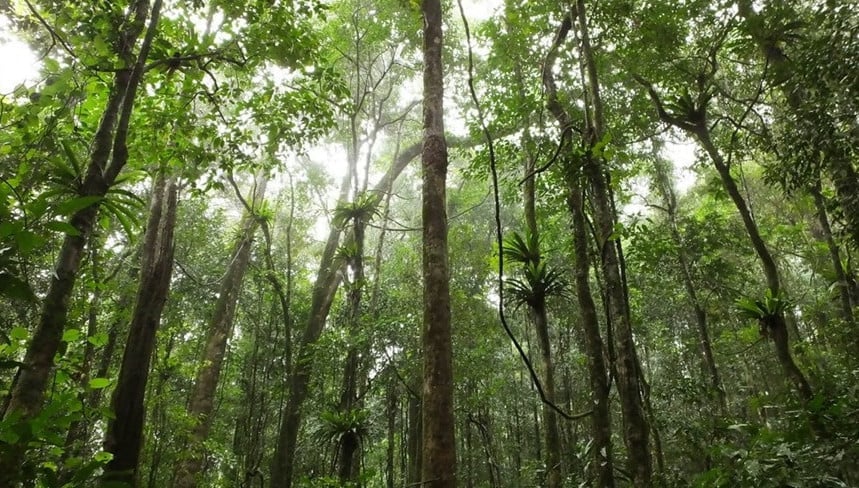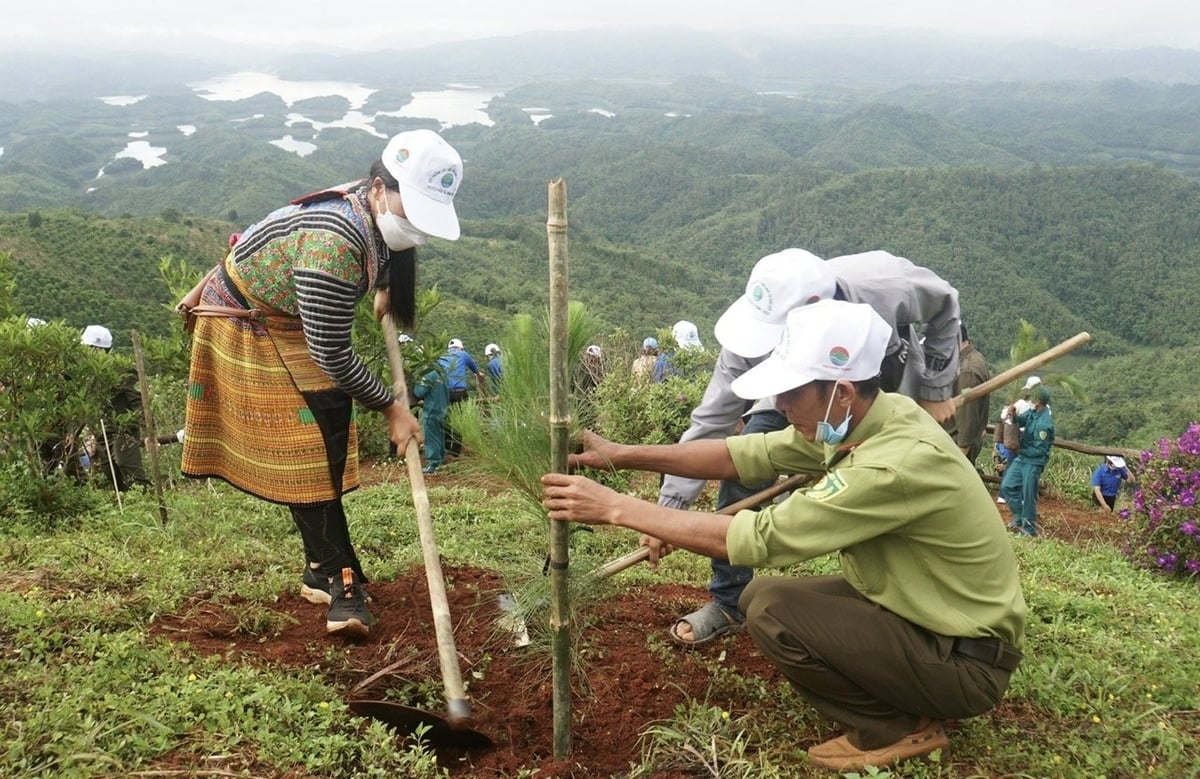December 4, 2025 | 13:26 GMT +7
December 4, 2025 | 13:26 GMT +7
Hotline: 0913.378.918
December 4, 2025 | 13:26 GMT +7
Hotline: 0913.378.918
The complete Ta Dung commune in Lam Dong Province is home to Ta Dung National Park (TDNP). The park, which covers more than 20,000 hectares of special-use forest, is of considerable ecological and biodiversity value. It is home to a variety of uncommon and endangered species of flora and fauna, including those listed in the Red Books of Vietnam and the world.

The forests in Ta Dung National Park are strictly protected thanks to the cooperation of the indigenous community.
In recent years, the management board of TDNP has implemented a variety of integrated solutions to protect the forest and its biodiversity effectively. A highlight among these is the forest protection contracting model, which involves assigning forest protection responsibilities to households living near the forest, most of whom are from ethnic minority communities. At present, the park has contracted more than 3,000 hectares of forest to community organizations and household collectives in order to engage in the conservation of forest resources.
Mr. Khuong Thanh Long, Director of Ta Dung National Park, has stated that forest protection cannot be solely dependent on professional rangers. It requires the mobilisation of local people. The contracting model fortifies the connection between people and the forest, generates additional income through conservation efforts, and enhances their environmental awareness and accountability.
"People living near the forest know every trail and tree. When they become forest guardians, their impact is far greater. Much more critically, they consider forest protection as a means of ensuring the survival of their own families and communities", Mr. Long disclosed.

Mr. Khuong Thanh Long, Director of Ta Dung National Park, next to the precious tree that has been preserved for hundreds of years.
The park's management board also conducts training sessions to improve tracking skills and legal knowledge related to wildlife conservation and forest protection, in addition to contracting forest protection. Each year, the contracted households collaborate with rangers to conduct routine surveillance and inspections, which aid in the identification and rapid resolution of forest violations.
However, despite these favorable results, TDNP's conservation efforts continue to encounter substantial obstacles. The terrain is fragmented and rugged, with numerous forest areas situated deep within the park and remote from residential areas. Access to certain subzones is exceedingly challenging during the rainy season, which impedes enforcement and patrols.
Additionally, slash-and-burn cultivation, illegal land encroachment, and spontaneous migration into the buffer zones continue to be intricate and enduring concerns. These activities present a continual threat to endangered species and forest resources. However, the forest protection personnel and ranger force continue to be understaffed and lack adequate transportation and equipment.
"The vast area, steep terrain, and fractured landscape make it extremely challenging to monitor the entire forest. Sometimes our teams must walk dozens of kilometers through the forest, especially on rainy days when patrolling becomes even more strenuous", Mr. Long added.
The management board is currently reforming the forest protection contracting model to resolve these issues. Efforts to increase accountability include conducting unannounced inspections and improving cross-monitoring among contractor organizations. The park also proposes that higher authorities invest in building more patrol trails, establishing additional ranger stations in border zones, and upgrading equipment for field operations.
TDNP's vision extends beyond the sole purpose of forest protection. It establishes a connection between sustainable conservation and local livelihoods. The park is in the process of creating models to assist forest-adjacent communities in developing sustainable incomes beneath the forest canopy. These models include the cultivation of indigenous medicinal plants, the harvesting of non-timber forest products, and the participation in regulated community-based ecotourism.

The Ta Dung National Park rangers cooperate with functional agencies and indigenous people to plant more trees.
According to Mr. Khuong Thanh Long, livelihood security must be concurrent with effective conservation. People will experience a greater sense of connection and commitment to the forest's long-term protection when they observe the tangible benefits it provides. "Conservation cannot be the sole responsibility of specialised forces. When the forest truly provides livelihoods and value, local people themselves become its best protectors", Mr. Long emphasised.
In the long term, TDNP will continue in its efforts to establish a comprehensive biodiversity database, implement technology in forest monitoring, and pursue additional conservation funding through partnerships with international organizations and research institutions. These endeavors are consistent with contemporary conservation strategies and Vietnam's National Biodiversity Strategy to 2030, which has a vision of 2050. Ta Dung National Park is becoming a paradigm for nature conservation in the Central Highlands by emphasizing community-based conservation and integrating forest protection with livelihood enhancement.
Translated by Linh Linh

(VAN) As of 2025, the ASEAN region has a total of 69 ASEAN Heritage Parks recognized across its 10 member states. Among them, Viet Nam contributes 15 ASEAN Heritage Parks.

(VAN) Yok Don National Park has high biodiversity with numerous endemic plant and animal species, and it is also the only dipterocarp forest ecosystem conservation area in Viet Nam.

(VAN) Viet Nam and Brunei signed two important MOUs on fisheries and IUU, expanding cooperation in agriculture, the environment, and Halal exports, aiming to substantively implement joint projects.

(VAN) The Viet Nam Coconut Association worked with the International Finance Corporation (IFC) and businesses to promote the supply chain, enhance competitiveness, and develop the coconut industry sustainably.
![Hue aims for Net Zero: [2] Pioneering low-emission tourism](https://t.ex-cdn.com/nongnghiepmoitruong.vn/608w/files/huytd/2025/12/04/0633-dulichzero-4-095634_236-161125.jpg)
(VAN) The ancient capital of Hue has developed Net Zero tourism products and models, aiming to reduce carbon emissions and pioneer the establishment of Viet Nam's green tourism destination.

(VAN) C.P. Viet Nam has announced the successful completion of its goal to plant 1.5 million trees during the 2021-2025 period, a key milestone within company's long-term ESG strategy and its roadmap for emission reduction.

(VAN) This is an initiative of MAE aimed at creating a unified coordination mechanism to implement agricultural cooperation programs with developing countries.